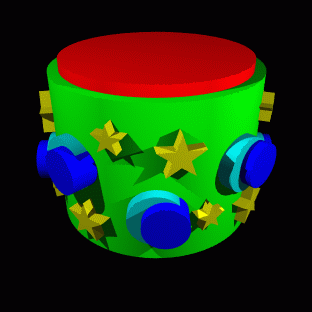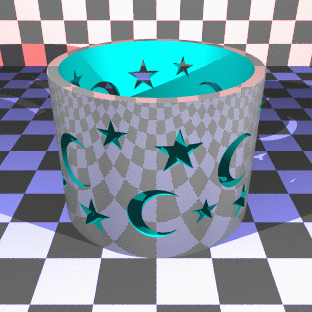
 The two primitives: a sphere and a box.
The two primitives: a sphere and a box.
 The union of the two primitives.
The union of the two primitives.
 The intersection of the two primitives.
The intersection of the two primitives.
 The difference of the two primitives: box minus sphere.
The difference of the two primitives: box minus sphere.
CSG is covered in FvDFH sections 12.7 and 15.10.3.
The following example illustrates the three CSG operations in use on simple three dimensional primitives.

 The two primitives: a sphere and a box.
The two primitives: a sphere and a box.
 The union of the two primitives.
The union of the two primitives.
 The intersection of the two primitives.
The intersection of the two primitives.
 The difference of the two primitives: box minus sphere.
The difference of the two primitives: box minus sphere.
The following example, based on FvDFH Plate III.2, shows an
object for which CSG is (probably) the only sensible modelling
technique. The object rendered in the right-hand image is constructed
from the primitives shown in the left-hand image. It is mostly made
out of cylinders.



 At right, I tried the "Godel, Escher, Bach" treatment on my initials.
Unfortunately the letters N, A, and D are not as amenable to this as
the letters G, E, and B: notice that the shadow of the N has a slight
curve at its top right, owing to the N's intersection with the curve
on the D and the slope on the A. Various other arrangements of the
three letters were tried, all of which gave more noticable artefacts
than this. Each of the letters is a CSG object (the D, for example,
is constructed from cylinders and boxes). The final effect is produced
simply by intersecting the three letters.
At right, I tried the "Godel, Escher, Bach" treatment on my initials.
Unfortunately the letters N, A, and D are not as amenable to this as
the letters G, E, and B: notice that the shadow of the N has a slight
curve at its top right, owing to the N's intersection with the curve
on the D and the slope on the A. Various other arrangements of the
three letters were tried, all of which gave more noticable artefacts
than this. Each of the letters is a CSG object (the D, for example,
is constructed from cylinders and boxes). The final effect is produced
simply by intersecting the three letters.
Exercises
|